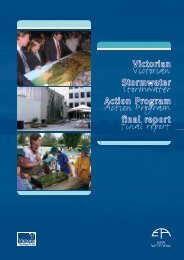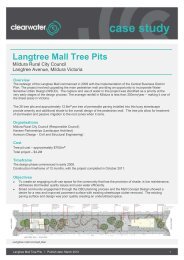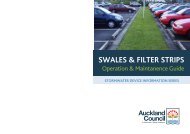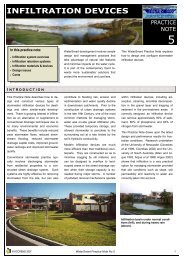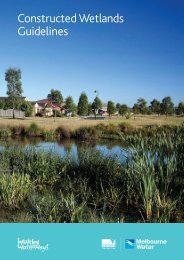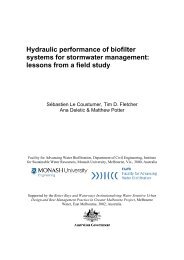CRC Street Sweep Eval 1999.pdf( 489.9 KB ) - Clearwater
CRC Street Sweep Eval 1999.pdf( 489.9 KB ) - Clearwater
CRC Street Sweep Eval 1999.pdf( 489.9 KB ) - Clearwater
You also want an ePaper? Increase the reach of your titles
YUMPU automatically turns print PDFs into web optimized ePapers that Google loves.
COOPERATIVE RESEARCH CENTRE FOR CATCHMENT HYDROLOGY<br />
2 Background<br />
2.1 <strong>Street</strong> <strong>Sweep</strong>ing Pollutant Removal<br />
Monitoring<br />
The role and usefulness of street sweepers to control<br />
street surface pollutants was first investigated in the<br />
late 1950’s and early 1960’s by the United States<br />
Environmental Protection Agency (US-EPA) and its<br />
associated researchers. Many of the US-EPA’s<br />
National Urban Runoff Program (NURP) studies<br />
measured the efficiency of street sweeping as a<br />
stormwater pollution control method with particular<br />
emphasis placed on sediment and sediment-bound<br />
contaminants.<br />
Since the late 70’s studies have measured street<br />
sweeping effectiveness in terms of the reduction in<br />
end-of-pipe runoff pollution concentrations and loads<br />
rather than assessing the effectiveness of specific<br />
equipment. Sartor and Boyd (1972) found sweeping<br />
schedules based on a seven day cycle to be almost<br />
totally ineffective while daily sweeping was shown to<br />
potentially have a high level of pollutant removal for<br />
larger sized pollutants typical of street surface<br />
material (Sartor and Gaboury, 1984). Pitt and<br />
Shawley (1982) and Bannerrnan et al. (1983)<br />
concluded that only minor benefits to stormwater<br />
quality are provided by street sweeping practices.<br />
However, Terstrierp et al. (1982) and Pitt and<br />
Bissonette, (1984) demonstrated that street sweeping<br />
collects significant amounts of particles, for select<br />
particle size ranges, from street surfaces. The overall<br />
conclusion reached by the US-EPA, was that, as a<br />
water quality best management practice, street<br />
sweeping did not appear to be effective at reducing<br />
end-of-pipe urban runoff pollutant loads.<br />
Subsequent investigations into the effectiveness of<br />
street sweeper mechanisms for water quality<br />
improvement report findings that vary to those<br />
presented in the conclusions of the earlier NURP<br />
studies. Alter (1995) and Sutherland and Jelen<br />
(1996b) assert that the NURP studies concluded that<br />
street sweeping is largely ineffective, because the<br />
sweepers used at the time of these studies were not<br />
able to effectively remove very fine accumulated<br />
sediments which are often highly contaminated.<br />
Sutherland and Jelen (1996a) suggest that street<br />
sweeping can significantly reduce pollutant washoff<br />
from urban streets due to the improved efficiencies of<br />
newer technologies now employed to conduct street<br />
sweeping in some American states. Their<br />
investigations showed that when street sweeping<br />
mechanisms and programs are designed to remove<br />
finer particles (ie. small-micron surface cleaners or<br />
tandem sweeping) it can benefit stormwater runoff<br />
quality.<br />
2.2 Modelling <strong>Sweep</strong>er Pollutant Removal<br />
Efficiencies<br />
<strong>Sweep</strong>ing technologies with the ability to effectively<br />
remove accumulated sediments, including fine<br />
particles, may significantly increase the efficiency of<br />
sweeping for the removal of a variety of stormwater<br />
pollutants. Sutherland and Jelen (1993) described the<br />
use of a calibrated version of the Simplified Particle<br />
Transport Model (SIMPTM) as being able to<br />
accurately simulate the complicated interaction of<br />
accumulation, washoff, and street sweeper removal<br />
that occurs over a time period. For varying street<br />
sweeping operations Sutherland and Jelen (1997)<br />
employed the SIMPTM to predict the average annual<br />
expected reduction in total suspended solids (TSS) at<br />
two sites in Portland, Oregon. <strong>Sweep</strong>ers used in their<br />
simulations included the NURP era broom sweeper, a<br />
mechanical broom sweeper, a tandem operation<br />
involving a mechanical broom followed by a vacuum<br />
sweeper and a newer technology, the small-micron<br />
sweeper. The predicted reductions in TSS showed<br />
that all of the newer street sweeping technologies are<br />
significantly more effective than the NURP era broom<br />
sweeper. It was further concluded that new street<br />
sweeping technologies designed for effective removal<br />
of fine particles, are capable of removing significant<br />
sediment loads and associated pollutants from urban<br />
street surfaces.<br />
In a further study Sutherland and Jelen (1998)<br />
compared the new small-micron street sweeping<br />
technology to wet vaults, a widely used stormwater<br />
quality treatment method. The ability of the smallmicron<br />
street sweeper to achieve significant<br />
reductions in urban pollutant washoff led Sutherland<br />
and Jelen to consider it an effective Best Management<br />
Practice (BMP) for stormwater pollution control.<br />
3




